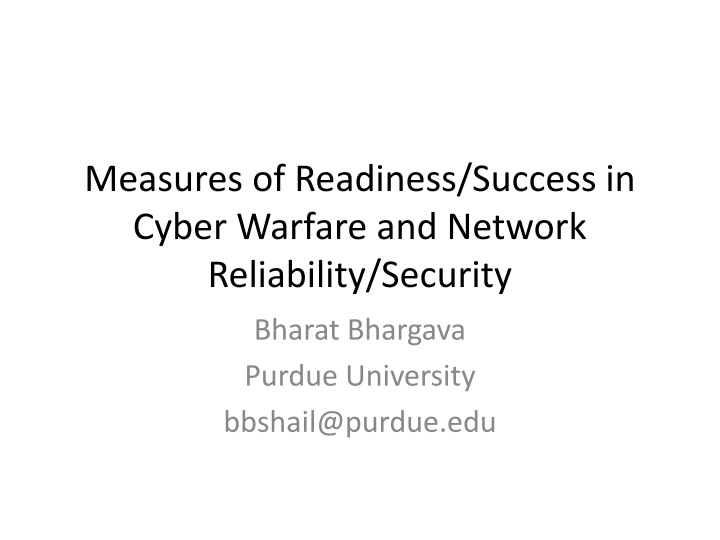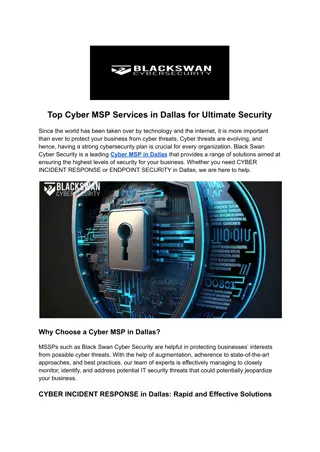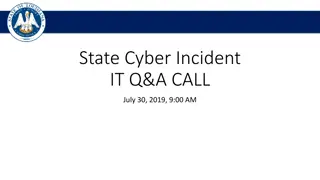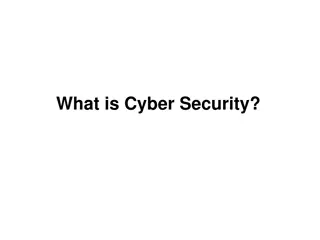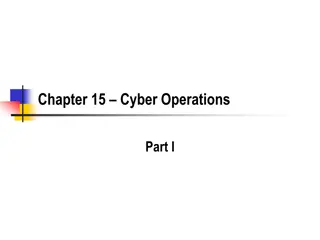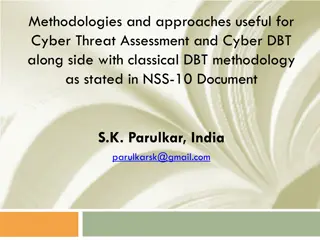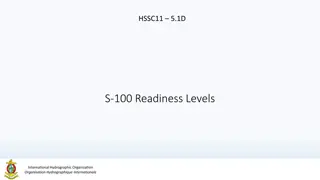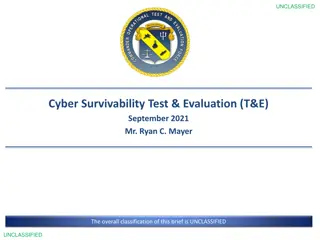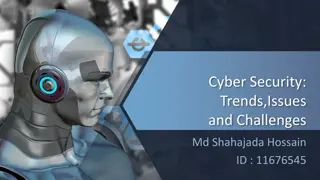Enhancing Cyber Warfare Readiness through Reliable Security Measures
"Focused on cybersecurity operations and warfare readiness, this research by Bharat Bhargava at Purdue University, along with collaborators Benny Cheng, Louis Joseph, and Iris Kaneshiro, aims to identify effective measures for enhancing network reliability and security in the face of cyber threats."
Download Presentation

Please find below an Image/Link to download the presentation.
The content on the website is provided AS IS for your information and personal use only. It may not be sold, licensed, or shared on other websites without obtaining consent from the author.If you encounter any issues during the download, it is possible that the publisher has removed the file from their server.
You are allowed to download the files provided on this website for personal or commercial use, subject to the condition that they are used lawfully. All files are the property of their respective owners.
The content on the website is provided AS IS for your information and personal use only. It may not be sold, licensed, or shared on other websites without obtaining consent from the author.
E N D
Presentation Transcript
Measures of Readiness/Success in Cyber Warfare and Network Reliability/Security Bharat Bhargava Purdue University bbshail@purdue.edu
Collaborators Benny Cheng Louis Joseph Iris Kaneshiro
Focus of Research Identify measures for cyber operations and warfare readiness Effects of reliability considering failures and attacks on readiness and mission assurance Identify attacks on computer networks and how to deal with them How to build adaptable system that can degrade gracefully, increase maintainability, and deal with adversity How to deal with vulnerabilities and threats How to test for effects of failures on cyber systems such as ship network and missile network Plan to deal with permanent/intermittent failures and attacks (coordinated, incognito, persistent) or frauds
Quality of Service (QoS) Parameters Service level Agreements (SLA) Timeliness, Accuracy, and Precision ( TAP) of information flow Connectivity, Latency, Loss of messages, Packet delivery ratio in network Access control violation, Mistaken identity, Loss of privacy, Leakage of data Service availability to shipboard users, Volume of user requests satisfied, Availability of individual services, Impact of these service on various missions User-perceived service availability, Number of users who lose service Types, Duration, Timing, Extent, Severity of Cyber Attacks that can be defended Capability for Adaptability, Cost and benefits of dynamic reconfiguration Analytical, Simulation, Emulation and Real execution comparisons on QoS parameters Under what situations, what is the loss of reliability, availability ,and readiness and impact on ship Capability for automatic and comprehensive defense and attacks Operation preparedness and evaluation tools
Parameters of Interest Number or percentage of good nodes Number of percentage bad nodes Number of active bad nodes Number of idle bad nodes Number of evicted ( bypassed) bad nodes Random attacker, Persistent attacker, insidious attacker Per node IDS-Probabilities of ( false positive and false negative)
Parameters of Interest Randon attack probability by a random attacker Attack probability Impairment rate for an attacker to cause severe functional impairement
Measures and Effects System minimum compliance threshold Minimum threshold set by the system for a persistent attack Compliance degree of a bad node, good node, arbitrary node
Security Failure Conditions If one third or more of the nodes are compromised, then the system fails. The reason is that consensus is no more possible. Compromised node performing active attack without being impacted can impair the functionality and cause the system to fail. Impairment failure is modeled by defining an impairment-failure attack period by a compromised node beyond which the system cannot sustain the damage.
Byzantine failure This is defined as a failure whose actions can not be predicted. The failure disappears suddenly, reappears and behaves in multiple modes. So nothing can be believed about the data and consensus is not possible
Behavior of Attacks Source of attack ( Is it from a specific country whose capabilities are known and understood?). Is it from an internal source or external? Do we know the communication channel that the attacker is using? Do we know what communication characteristics are needed for the attacker to reach our critical infrastructure?
Types of Attack Malware Distribution: Hackers with malicious intent can exploit your email client by distributing malware through email messages. The malware includes viruses, worms, rootkits, Trojans, keyloggers, spyware, and adware, to name a few types. The malware is distributed via an email attachment or sometimes by simply opening an email message. More often than not, the mail message is disguised as a message from someone you know when in reality; it is sent by the hacker. Phishing Attack: A phishing attack is generally not hazardous to the inner workings of your PC however; it is designed to trick you into revealing your personal information, passwords, or bank account information. For example, if you use PayPal, the phisher sends you a message that looks like it came from PayPal. The message requests you to verify your account information with PayPal to continue using your account. The message proceeds to tell you that if you do not verify the information your account will be closed. Someone that is unaware of phishing scams easily gets tricked into revealing their account information. These types of messages are set up to look like the real deal. Spam Attack: Spam is unsolicited email or "junk" mail that you receive in your Inbox. Spam generally contains advertisements but it can also contain malicious files. When you click on spam, the files are downloaded into your email client and into your PC. The same thing can happen if you reply to spam in an attempt to get removed from the list.
Types of Attacks Denial of Service Attack: A denial of service attack occurs when the hacker sends multitudes of email messages to your email client in an effort to block you from using your email client or crashing your computer altogether. In the case of an organization, a denial of service attack on email can crash an entire network and prevent the users from responding to legitimate traffic. Eavesdropping - This is the process of listening in or overhearing parts of a conversation. It also includes attackers listening in on your network traffic. Its generally a passive attack, for example, a coworker may overhear your dinner plans because your speaker phone is set too loud. The opportunity to overhear a conversation is coupled with the carelessness of the parties in the conversation. Snooping - This is when someone looks through your files in the hopes of finding something interesting whether it is electronic or on paper. In the case of physical snooping people might inspect your dumpster, recycling bins, or even your file cabinets; they can look under your keyboard for post-It-notes, or look for scraps of paper tracked to your bulletin board. Computer snooping on the other hand, involves someone searching through your electronic files trying to find something interesting. Interception - This can be either an active or passive process. In a networked environment, a passive interception might involve someone who routinely monitors network traffic. Active interception might include putting a computer system between sender and receiver to capture information as it is sent. From the perspective of interception, this process is covert. The last thing a person on an intercept mission wants is to be discovered. Intercept missions can occur for years without the knowledge of the intercept parties.
Types of Attacks Modification Attacks - This involves the deletion, insertion, or alteration of information in an unauthorized manner that is intended to appear genuine to the user. These attacks can be very hard to detect. The motivation of this type of attack may be to plant information, change grades in a class, alter credit card records, or something similar. Website defacements are a common form of modification attacks. Repudiation Attacks - This makes data or information to appear to be invalid or misleading (Which can even be worse). For example, someone might access your email server and inflammatory information to others under the guise of one of your top managers. This information might prove embarrassing to your company and possibly do irreparable harm. This type of attack is fairly easy to accomplish because most email systems don't check outbound email for validity. Repudiation attacks like modification attacks usually begin as access attacks.
Types of Attacks Denial-of-service Attacks - They prevent access to resources by users by users authorized to use those resources. An attacker may try to bring down an e- commerce website to prevent or deny usage by legitimate customers. DoS attacks are common on the internet, where they have hit large companies such as Amazon, Microsoft, and AT&T. These attacks are often widely publicized in the media. Several types of attacks can occur in this category. These attacks can deny access to information, applications, systems, or communications. A DoS attack on a system crashes the operation system (a simple reboot may restore the server to normal operation). A common DoS attack is to open as many TCP sessions as possible; This type of attack is called TCP SYN flood DoS attack. Two of the most common are the ping of death and the buffer overflow attack. The ping of death operates by sending Internet control message protocol (ICMP) packets that are larger than the system can handle. Buffer overflow attacks attempt to put more data into the buffer than it can handle. Code red, slapper and slammer are attacks that took advantage of buffer overflows, sPing is an example of ping of death.
Types of Attacks Distributed Denial-of-service Attacks - This is similar to a DoS attack. This type of attack amplifies the concepts of DoS attacks by using multiple computer systems to conduct the attack against a single organization. These attacks exploit the inherent weaknesses of dedicated networks such as DSL and Cable. These permanently attached systems have little, if any, protection. The attacker can load an attack program onto dozens or even hundreds of computer systems that use DSL or Cable modems. The attack program lies dormant on these computers until they get attack signal from the master computer. This signal triggers these systems which launch an attack simultaneously on the target network or system. Back door Attacks - This can have two different meanings, the original term back door referred to troubleshooting and developer hooks into systems. During the development of a complicated operating system or application, programmers add back doors or maintenance hooks. These back doors allow them to examine operations inside the code while the program is running. The second type of back door refers to gaining access to a network and inserting a program or utility that creates an entrance for an attacker. The program may allow a certain user to log in without a password or gain administrative privileges. A number of tools exist to create a back door attack such as, Back Orifice (Which has been updated to work with windows server 2003 as well as erlier versions), Subseven,NetBus, and NetDevil. There are many more. Fortunately, most anti-virus software will recognize these attacks.
Types of Attacks Spoofing Attacks - This is an attempt by someone or something to masquerade as someone else. This type of attack is usually considered as an access attack. The most popular spoofing attacks today are IP spoofing and DNS spoofing. The goal of IP spoofing is to make the data look like it came from a trusted host when it really didn't. With DNS spoofing, The DNS server is given information about a name server that it thinks is legitimate when it isn't. This can send users to a website other than the one they wanted to go to. Man-in-the-Middle Attacks - This can be fairly sophisticated, This type of attack is also an access attack, but it can be used as the starting point of a modification attack. This involves placing a piece of software between a server and the user that neither the server administrators nor the user are aware of. This software intercepts data and then send the information to the server as if nothing is wrong. The server responds back to the software, thinking it's communicating with the legitimate client. The attacking software continues sending information to the server and so forth. Replay Attacks - These are becoming quite common, This occur when information is captured over a network. Replay attacks are used for access or modification attacks. In a distributed environment, logon and password information is sent over the network between the client and the authentication system. The attacker can capture this information and replay it later. This can also occur security certificates from systems such as kerberos: The attacker resubmits the certificate, hoping to be validated by the authentication system, and circumvent any time sensitivity.
Types of Attacks Collusive attacks- Multiple attacks from multiple sources collaborate ( intentionally or unintentionally) to increase damage at faster pace ( speed)
Extent of Attack Is the attack causing the mission to fail? Is the attack causing only superficial ( at the periphery of the network at non critical nodes) Is the attack penetrating the system and moving close to critical components? Is the attack affecting multiple routes ( paths) in the network?
Duration of Attack Is it a one time attack that disappears ( goes away in a short period of time)? Is it a persistent attack that stays in system unless removed or dealt with ? Does it cause other attacks to succeed (through cascade) and thus has a long term effect? Does it escape detection time period?
Network Reliability Network reliability refers to the reliability of the overall network to provide communication in the event of failure of a component or components in the network The term fault-tolerant is used to refer to how reliable a particular component (element) of a network is (e.g., a switch or a router). The term fault-tolerant network, on the other hand, refers to how resilient the network is against the failure of a component.
Network Reliability Considerations Communication network reliability depends on the sustainability of both hardware and software. A variety of network failures, lasting from a few seconds to days depending on the failure, is possible. Traditionally, such failures were primarily from hardware malfunctions that result in downtime (or outage period") of a network element (a node or a link). Thus, the emphasis has been on the element-level network availability and, in turn, the determination of overall network availability. However, other types of major outages have received much attention in recent years. Such incidents include accidental fire, fiber cable cut, natural disasters, and malicious cyber attack (both hardware and software). These major failures need more than what is traditionally addressed through network availability.
Dealing with failure or attack Failures can drop a significant number of existing network connections. The network is required to have the ability to detect a fault/misbehaving link/node and isolate/bypass it. The network must reconnect or reroute the packets through a slow/longer or less trusted or securedroute. The network may not have enough capacity and capability to handle such a major simultaneous reconnect" phase. Security officer may need to stop communication manually or agree to support degraded or partial services. Redundancy and adaptability underlies all approaches
Adaptability and Dynamic Reconfiguration The challenge in adaptability is to configure set of components that conform to the security policy requirements. A dynamically reconfigured system composition is based on changes in the context with respect to timeliness and accuracy of information as well as the type, duration, extent of attacks and the complexity of the threat environment. Configurability needs rules that allow applications and customers to set priorities, risk tolerance, and monitoring requirements.
Secure Service Orchestration Since there are multiple services in every service category, we face a new challenge of selecting the most secure service orchestration out of the available components. This problem gets more challenging, as we require meeting multiple criteria such as security, availability, and cost of a service, etc. These criteria are derived from the requirements of a service client as specified through SLA (service-level agreement) and security assurance. There are multiple routes with different SLA guarantees to be able to meet the requirements of clients. We investigate the problem of secure composition by formulating and formalizing it as a variation of famous Knapsack Problem [MT90]. We developed the efficient algorithms to find (near)-optimal solutions to this problem.
Dynamic Compositions of Components The goal of secure network composition is to maximize the resiliency and security of the system based on selecting the best individual components, while meeting the constraints (security and SLA requirements). Using the service monitor, we maintain the latest values for the QoS parameters of the components. Once there is a change in the QoS of a service, we evaluate the alternative orchestrations to find the most secure composition. If the new service composition is different from the current deployment, one of a few components could be replaced with other services in the same categories to maximize the overall security. While switching the services, we will take advantage of VMware software called Vsphere. The optimal selection of components is NP-complete.
Finding the Shortest Route Dijkstra's Algorithm: A common example of a graph-based pathfinding algorithm is Dijkstra's algorithm. This algorithm begins with a start node and an "open set" of candidate nodes. At each step, the node in the open set with the lowest distance from the start is examined. The node is marked "closed", and all nodes adjacent to it are added to the open set if they have not already been examined. This process repeats until a path to the destination has been found. Since the lowest distance nodes are examined first, the first time the destination is found, the path to it will be the shortest path. One must additionally consider congestion of routes, currency of information at each node selected in the path, trustworthiness of paths. AODV is one such protocol used by Manets.
Active Bundle Scheme Metadata: Access control policies Data integrity checks Dissemination policies Life duration ID of a trust server ID of a security server App-dependent information Sensitive Data: Identity Information ... Virtual Machine (algorithm): Interprets metadata Checks active bundle integrity Enforces access and dissemination control policies E(Name) E(E-mail) E(Password) E(Shipping Address) E(Billing Address) E(Credit Card) 31 * E( ) - Encrypted Information
Resiliency and Adaptability We achieve resiliency of a system through switching failed or compromised services to more reliable versions. It requires the transfer of the state of the current service to a new virtual machine, or Cloud. The ideas for building alternates services that are more resilient and trustworthy has been studied by us over the years and our laboratory built the RAID ( Reliable, Adaptable, Distributed) system based on these ideas. The goal is to provide non-stop operations in the presence of failures or attacks by dynamically configuring the system as the context and urgency of client s requirements.
Detecting Service Violation in Internet Problem statement Detecting service violation in networks is the procedure of identifying the misbehaviors of users or operations that do not adhere to network protocols. 33
Topology Used (Internet) Victim, V A3 uses reflector H3 to attack V H5 A1 spoofs H5 s address to attack V 34
Detecting DoS Attacks in Internet *SPIE: Source Path Isolation Engine 35
Research Directions Observe misbehavior flows through service level agreement (SLA) violation detection Core-based loss Stripe based probing Overlay based monitoring 36
Approach Develop low overhead and scalable monitoring techniques to detect service violations, bandwidth theft, and attacks. The monitor alerts against possible DoS attacks in early stage Policy enforcement and controlling the suspected flows are needed to maintain confidence in the security and QoS of networks 37
Methods Network tomography Stripe based probing is used to infer individual link loss from edge-to-edge measurements Overlay network is used to identify congested links by measuring loss of edge-to-edge paths Transport layer flow characteristics are used to protect critical packets of a flow Edge-to-edge mechanism is used to detect and control unresponsive flows 38
Monitoring Network Domains Idea: Excessive traffic changes internal characteristics inside a domain (high delay & loss, low throughput) Monitor network domain for unusual patterns If traffic is aggregating towards a domain (same IP prefix), probably an attack is coming Measure delay, link loss, and throughput achieved by user inside a network domain Monitoring by periodic polling or deploying agents in high speed core routers put non-trivial overhead on them 39
Overlay-based Monitoring Problem statement Given topology of a network domain, identify which links are congested Solutions: Simple and Advanced methods 1. Monitor the network for link delay If delayi > Thresholdidelay for path i, then probe the network for loss 2. If lossj > Thresholdjloss for any link j, then probe the network for throughput 3. If BWk > ThresholdkBW, flow k is violating service agreements by taking excess resources. Upon detection, we control the flows. 4. 40
Probing: Simple Method Congested link (a) Topology (b) Overlay (c) internal links Each peer probes both of its neighbors Detect congested link in both directions 41
An Example Perform one round peer-to-peer probing in counter-clockwise direction Each boolean variable Xij represents the congestion status of link i For each probe P, we have an equation Pi,j = Xi,k+ + Xl,j j 42
Experiments: Evaluation methodology Simulation using ns-2 Two topologies C-C links, 20 Mbps E-C links, 10 Mbps Parameters Number of flows order of thousands Change life time of flows Simulate attacks by varying traffic intensities and injecting traffic from multiple entry points Output Parameters delay, loss ratio, throughput Congested link Topology 1 43
Identified Congested Links Loss Ratio Loss Ratio Time (sec) Time (sec) (a) Counter clockwise probing (b) Clockwise probing Probe46 in graph (a) and Probe76 in graph (b) observe high losses, which means link C4 E6 is congested. 44
False Positive (theoretical analysis) The simple method does not correctly label all links The unsolved good links are considered bad hence false positive happens Need to refine the solution Advanced Method 45
Performance: Simple Method Theorem 2. Let p be the probability of a link being congested in any arbitrary overlay network. The simple method determines the status of any link of the topology with probability at least 2(1- p)4-(1-p)7+p(1-p)12 Detection Probability Frac of actual congested links 46
Identifying Links: Advanced Method Loss Ratio Time (sec) Link E2 C2, C1 C3, C3 C4, and C4 E6 are congested. Simple method identifies all except E2 C2. Advanced method finds probe E5 E1 to identify status of E2 C2. 47
Analyzing Advanced Method Lemma 2.For an arbitrary overlay network with n edge routers, on the average a link lies on b = edge-to- edge paths Lemma 3.For an arbitrary overlay network with n edge routers, the average length of all edge-to-edge paths is d = Theorem 3.Let p be the probability of a link being congested. The advanced method can detect the status of a link with probability at least (1-(1-(1-p)d)b) 3 ( ) 2 n n log 8 n 3 n 2 log n 48
Bounds on Advanced Method Graph shows lower and upper bounds When congestion is 20%, links are identified with O(n) probes with probability 0.98 Does not help if 60% links are congested Detection Probability Frac of actual congested links Advanced method uses output of simple method and topology to find a probe that can be used to identify status of an unsolved link in simple method 49
Experiments: Delay Measurements % of traffic Delay (ms) Cumulative distribution function (cdf) Attack changes delay pattern in a network domain We need to know the delay pattern when there is not attack 50
